NCERT Solutions for Class 7 Maths Chapter 3 A Peek Beyond the Point
Page No. 47
The Need for Smaller Units
In the following figure, screws are placed above a scale. Measure them and write their length in the space provided.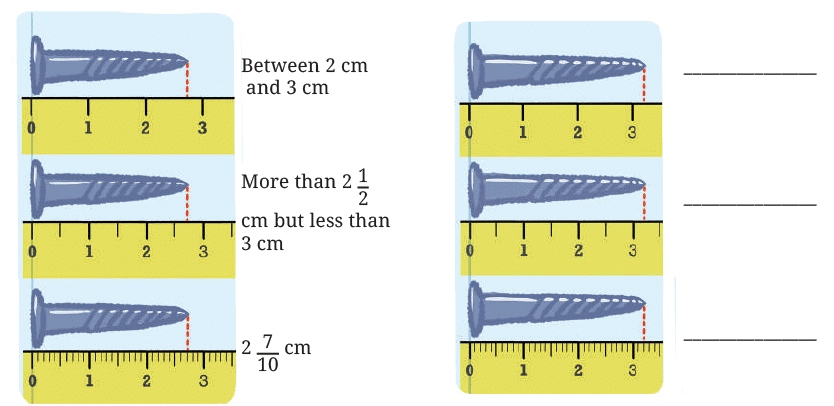
Ans: 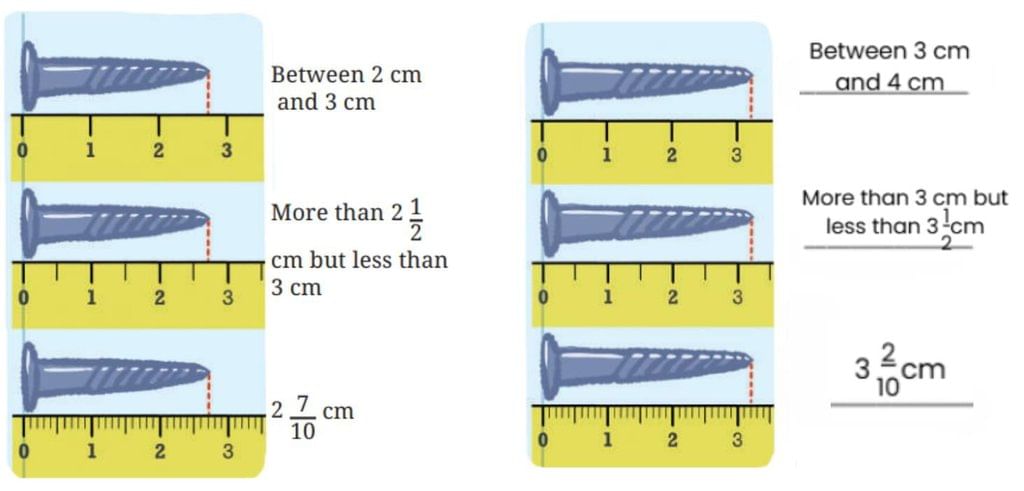
Q1: Which scale helped you measure the length of the screws accurately? Why?
Ans: The scale that is divided into 10 equal parts between each centimeter mark helped measure the screws accurately. This is because it shows each tenth of a centimeter clearly, helping us measure the screw length precisely.
So, the third scale helped us to measure the length of the screws.
Q2. What is the meaning of (the length of the first screw)?
(the length of the first screw)?
Ans:
It means that the length of the screw is two and seven-tenths centimeters.
Q3: Can you explain why the unit was divided into smaller parts to measure the screws?
Ans: Yes, as the screws are so long that cannot be measured in exact unit length. Therefore, the unit was divided into smaller parts.
Q4: Measure the following objects using a scale and write their measurements in centimeters (as shown earlier for the lengths of the screws): pen, sharpener, and any other object of your choice.
Ans: Do it Yourself!
Q5: Write the measurements of the objects shown in the picture: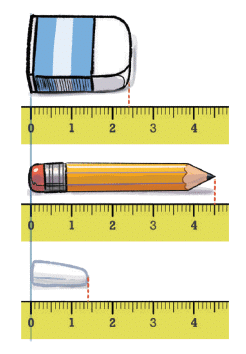
Ans: The picture, assuming typical objects:
- First Image Eraser:
 cm
cm - Second Image Pencil:
 cm
cm - Third Image Chalk:
 cm
cm
Page No. 49
Q1: For the objects shown below, write their lengths in two ways and read them aloud. An example is given for the USB cable. (Note that the unit length used in each diagram is not the same.)
The length of the USB cable is 4 and 8/10 units or 48/10 units.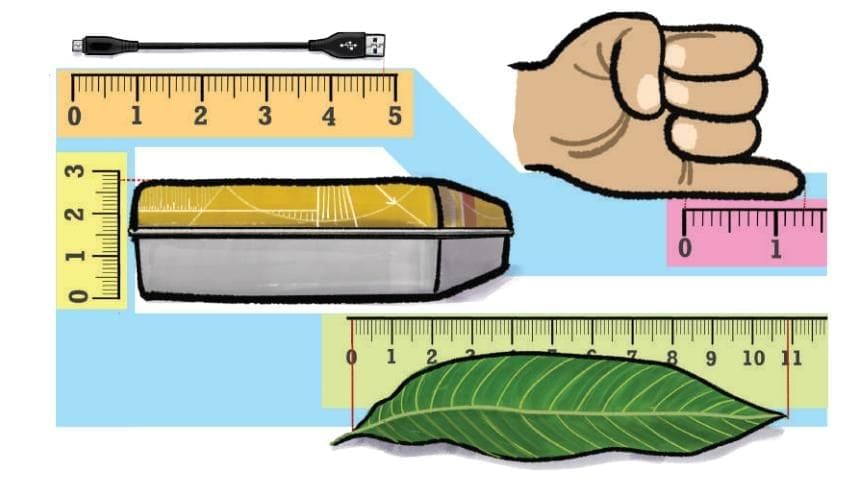
Ans: The length of the little finger is 1 and  units or
units or  units;
units;
The height of the geometry box is 2 and  units or
units or  units;
units;
and the length of a leaf is 10 and  units or
units or  units.
units.
Q2: Arrange these lengths in increasing order: Ans: (a)
Ans: (a)  → nine-tenths → 0.9
→ nine-tenths → 0.9
(b)  =
=  → one and seven-tenths or seventeen-tenths → 1.7
→ one and seven-tenths or seventeen-tenths → 1.7
(c)  → one hundred thirty-tenths → 13.0
→ one hundred thirty-tenths → 13.0
(d)  =
= → Thirteen and one-tenths or one hundred thirty-one tenths → 13.1
→ Thirteen and one-tenths or one hundred thirty-one tenths → 13.1
(e)  =
= → Ten and five-tenths or one hundred five tenths → 10.5
→ Ten and five-tenths or one hundred five tenths → 10.5
(f)  =
= → Seven and six-tenths or seventy-six tenths → 7.6
→ Seven and six-tenths or seventy-six tenths → 7.6
(g)  =
= → Six and seven-tenths or sixty-seven tenths → 6.7
→ Six and seven-tenths or sixty-seven tenths → 6.7
(h)  → four-tenths → 0.4
→ four-tenths → 0.4
These fractional units are in increasing order as:
Page No. 50 & 51
Q1: Arrange the following lengths in increasing order:
Ans: We can see that  =
= and
and 
Therefore, the given lengths can be arranged in increasing order as:
Q2: The lengths of the body parts of a honeybee are given. Find its total length.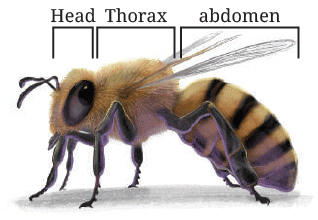
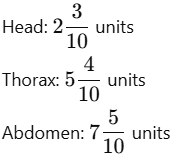
Ans: The total length of a honeybee = length of the head + length of the thorax + length of the abdomen
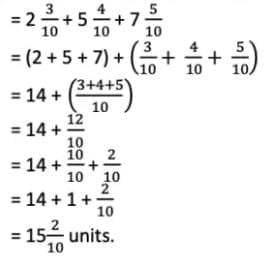
Q3: The length of Shylaja’s hand is  units, and her palm is
units, and her palm is  units. What is the length of the longest (middle) finger?
units. What is the length of the longest (middle) finger?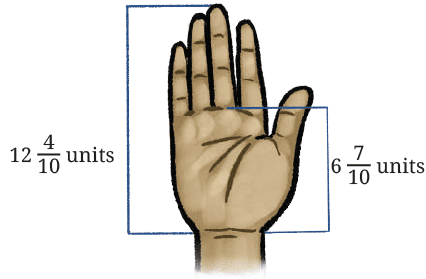
Ans: The length of the finger can be found by evaluating  This can be done in different ways. For example,
This can be done in different ways. For example,
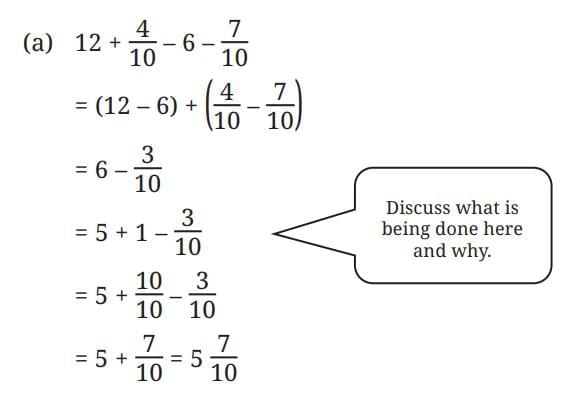
Break 6 into 5 + 1 to help with subtraction. Here, 1 is kept aside so we can subtract the fraction easily from it.
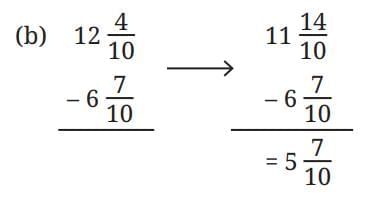
As in the case of counting numbers, it is convenient to start subtraction from the tenths. We cannot remove 7 one-tenths from 4 one-tenths. So we split a unit from 12 and convert it to 10 one-tenths. Now, the number has 11 units and 14 one-tenths. We subtract 7 one tenths from 14 one-tenths and then subtract 6 units from 11 units.
Page No. 52
Q1: Try computing the difference by converting both lengths to tenths.
Ans: Length of hand = units = units
Length of palm = units = units
Length of longer finger = Hand – Palm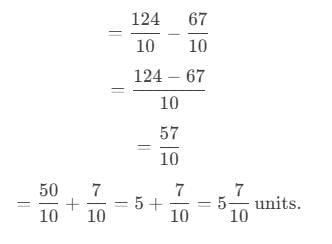
Q2: A Celestial Pearl Danio’s length is  cm, and the length of a Philippine Goby is 9/10 cm. What is the difference in their lengths?
cm, and the length of a Philippine Goby is 9/10 cm. What is the difference in their lengths?
Ans: The length of a Celestial Pearl Danio fish = cm
The length of a Philippine Goby fish = cm
So, the difference in their lengths =
= cm
= cm
Q3: How big are these fish compared to your finger? Ans: The Philippine Goby is 9/10 cm long. This is likely narrower and much shorter than an adult finger.
Ans: The Philippine Goby is 9/10 cm long. This is likely narrower and much shorter than an adult finger.
The Celestial Pearl Danio is 24/10 cm long. This might be slightly wider than an adult finger but is still much shorter than its length.
Q4: Observe the given sequences of numbers. Identify the change after each term and extend the pattern: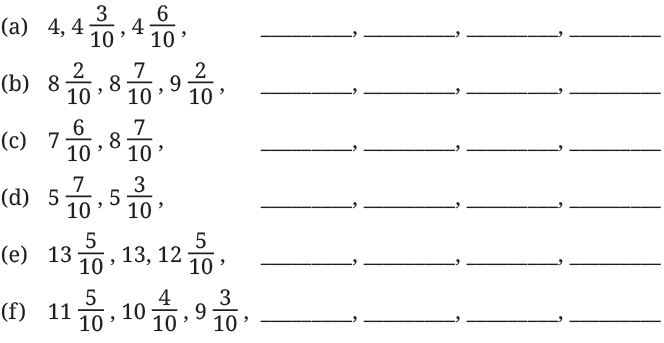
Ans: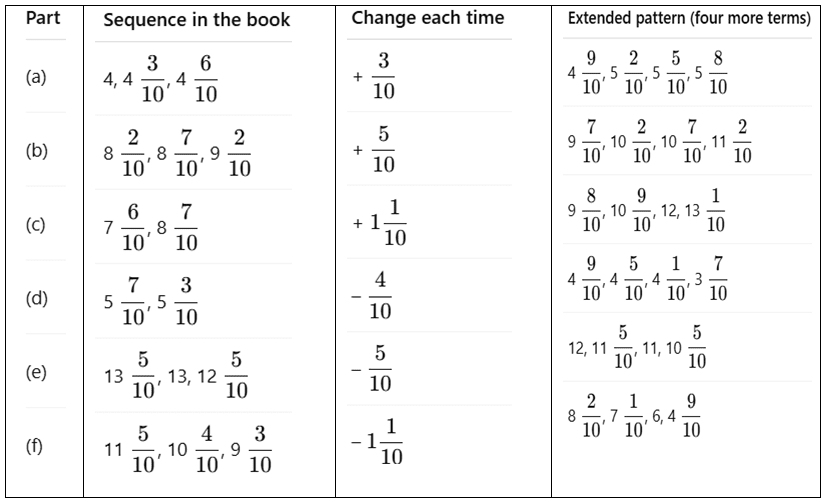
Page No. 53
Q1: How many one-hundredths make one-tenth? Can we also say that the length is 4 units and 45 one-hundredths?
Ans: 
Hence, 4 units and 4 one-tenths and 5 one-hundredths can also be written as 4 units and 45 one-hundredths.
Page No. 54
Q1: Observe the figure below. Notice the markings and the corresponding lengths written in the boxes when measured from 0. Fill the lengths in the empty boxes. Ans:
Ans: 
Q2: For the lengths shown below write the measurements and read out the measures in words.
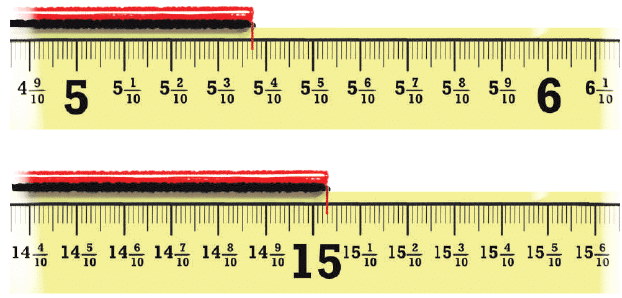
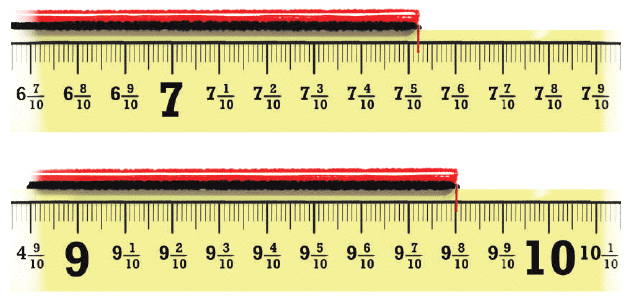 Ans: First Image:
Ans: First Image:
5 → Five and three-tenths and seven-hundredths
Or 5 → Five and thirty-seven-hundredths
Or → Five hundred thirty-seven-hundredths
Second Image: 
15 → Fifteen and three-hundredths
Or → One thousand five hundred three-hundredths
Third Image: 
7 → Seven and five-tenths and two-hundredths
Or 7 → Seven and fifty-two-hundredths
Or → Seven hundred fifty-two-hundredths
Fourth Image: 
9 → Nine and eight-tenths
Or → Nine and eighty-hundredths
Or → Nine hundred eighty-hundredths
Page No. 55
Q1: In each group, identify the longest and the shortest lengths. Mark each length on the scale.
Ans: 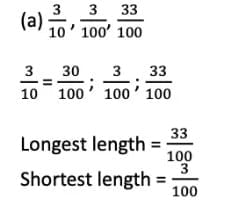


Ans: 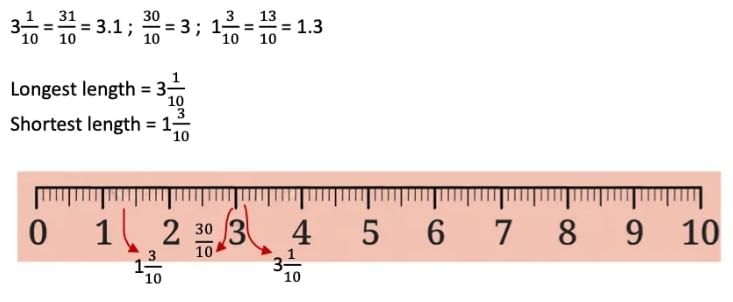

Ans: 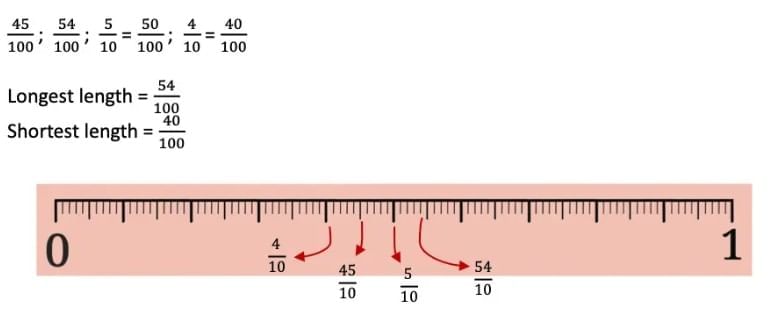

Ans: 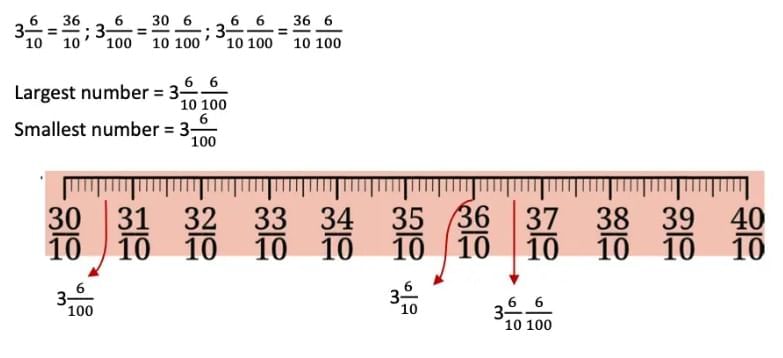

Ans: 

Ans: 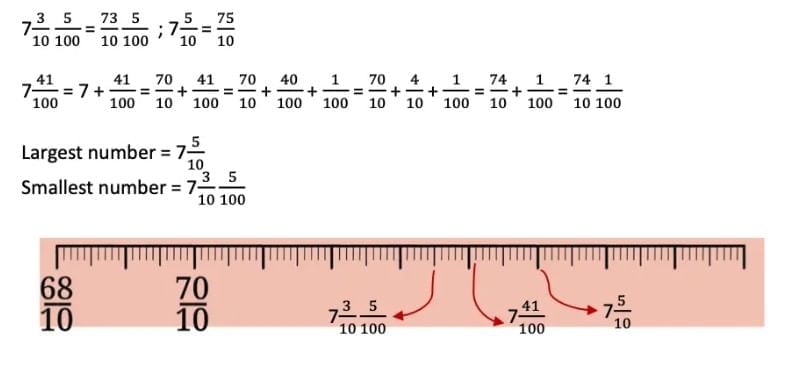

Ans: 

Page 56 & 57
Q1: What will be the sum of  and
and  ?
?
Ans: 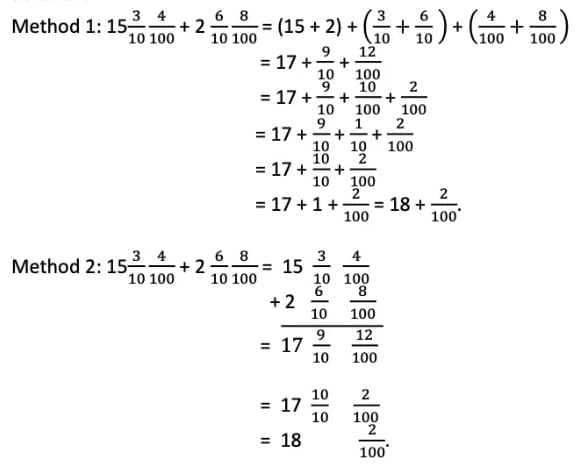
Q2: Are both these methods different?
Ans: No, both methods are the same in logic and result but differ in structure. Method 1 uses a step-by-step horizontal layout for addition, while Method 2 uses a vertical layout.
Page No. 58
Figure it Out
Q1: Find the sums and differences:
Ans: 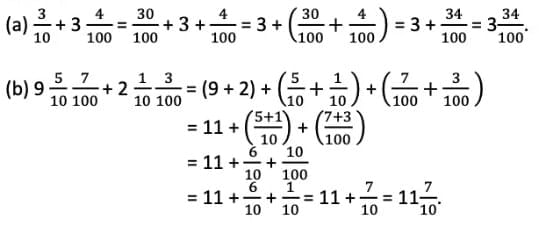
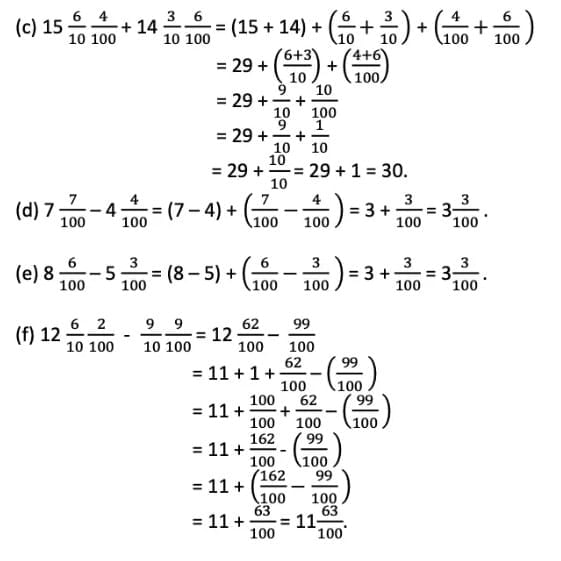
Page No. 59
Q1: Can we not split a unit into 4 equal parts, 5 equal parts, 8 equal parts, or any other number of equal parts instead?
Ans: Yes, we can. The example below compares how the same length is represented when the unit is split into 10 equal parts and when the unit is split into 4 equal parts.
If an even more precise measure is needed, each quarter can further be split into four equal parts. Each part then measures 1 /16 of a unit, i.e., 16 such parts make 1 unit.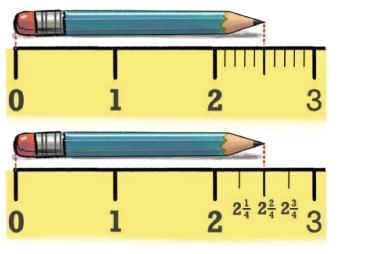
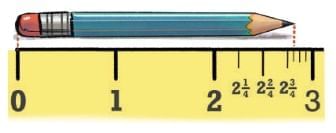 Q2: Then why split a unit into 10 parts every time?
Q2: Then why split a unit into 10 parts every time?
Ans: The reason is the special role that 10 plays in the Indian place value system.
For a whole number written in the Indian place value system — for example, 281 — the place value of 2 is hundreds (100), that of 8 is tens (10), and that of 4 is one (1). Each place value is 10 times bigger than the one immediately to its right. Equivalently, each place value is 10 times smaller than the one immediately to its left:
10 ones make 1 ten,
10 tens make 1 hundred,
10 hundreds make 1 thousand, and so on.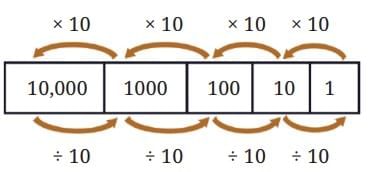
In order to extend this system of writing numbers to quantities smaller than one, we divide one into 10 equal parts. What does this give? It gives one-tenth. Further dividing it into 10 parts gives one-hundredth, and so on.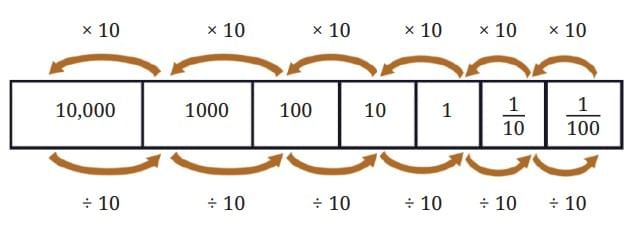
Page No. 60
Q1: Can we extend this further?
Ans: Yes, it can be extended on both sides infinitely.
Page No. 61
Q1: We can ask similar questions about fractional parts:
(a) How many thousandths make one unit?
(b) How many thousandths make one tenth?
(c) How many thousandths make one hundredth?
(d) How many tenths make one ten?
(e) How many hundredths make one ten?
Ans:
(a) Since, .
∴ 1000 thousandths make one unit.
(b) Since, .
∴ 100 thousandths make one tenth.
(c) Since, .
∴ 10 thousandths make one hundredth.
(d) Since, 0.
∴ 100 tenths make one ten.
(e) Since, .
∴ 1000 hundredths make one ten.
Q2: Make a few more questions of this kind and answer them.
Ans:
(a) How many hundredths make one unit?
(b) How many tenths make one unit?
(c) How many tenths make one hundredth?
(d) How many hundredths make one tenth?
(a) Since,
∴ 100 hundredths make one unit.
(b) Since,
∴ 10 tenths make one unit.
(c) Since,
∴ tenths make one hundredth.
(d) Since,
∴ 10 hundredths make one tenth.
Page No. 63
Q1: Make a place value table similar to the one above. Write each quantity in decimal form and in terms of place value, and read the number: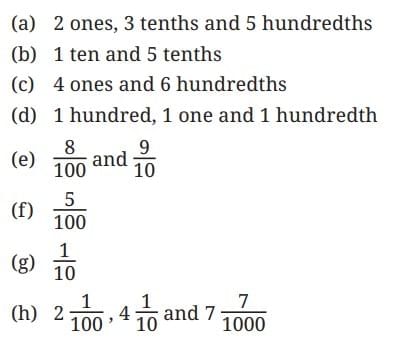
Ans: 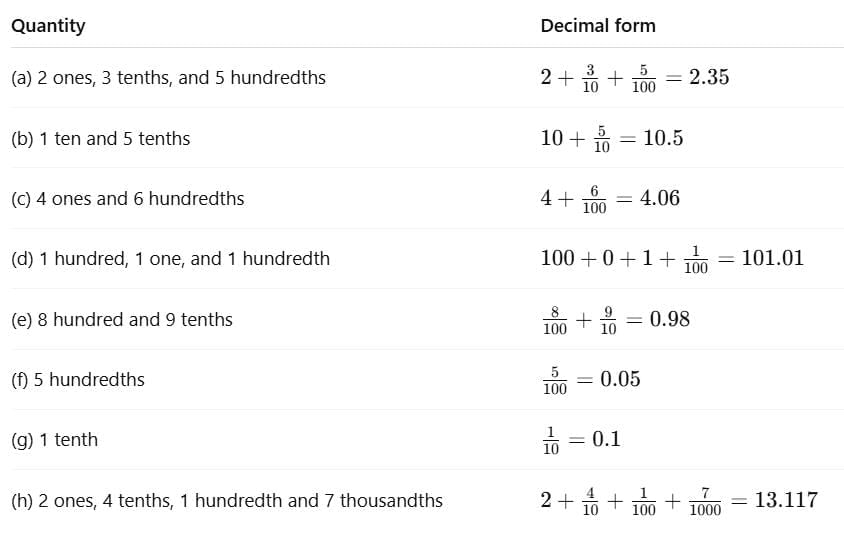
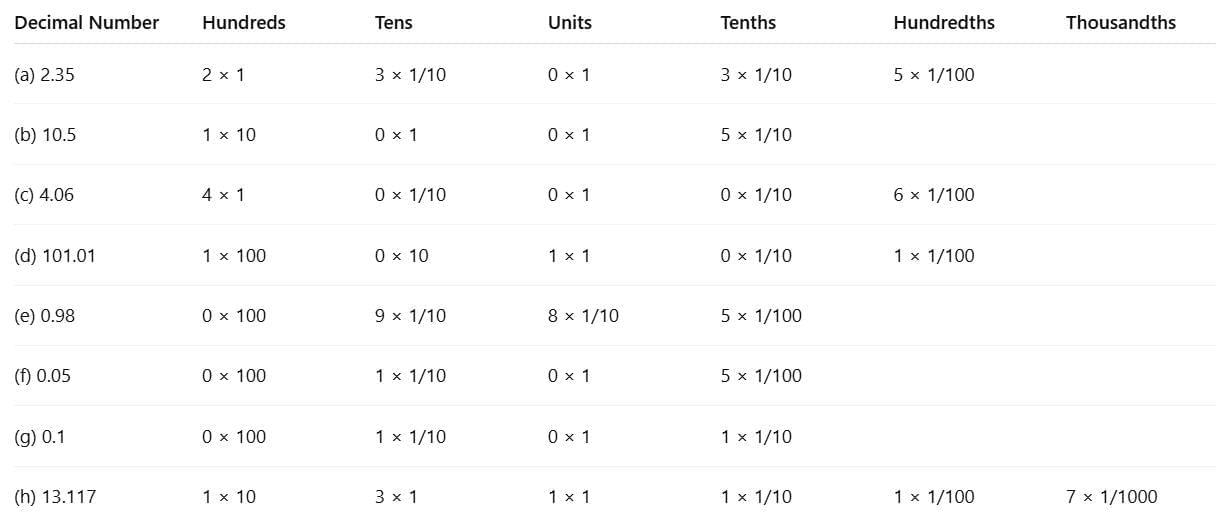
(a) 2.35 – Two point three five.
(b) 10.35 – Ten point three five.
(c) 4.06 – Four point zero six.
(d) 101.01 – One hundred one point zero one.
(e) 0.98 – zero point nine eight.
(f) 0.05 – zero point zero five.
(g) 0.1 – zero point one.
(h) 13.117 - Thirteen point one one seven
Page No. 64
Q1: Write these quantities in decimal form:
(a) 234 hundredths
Ans: 

(b) 105 tenths
Ans: 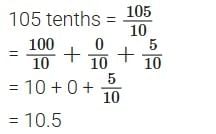

Page No. 65
Q1: Fill in the blanks below (mm ↔ cm):
Ans: 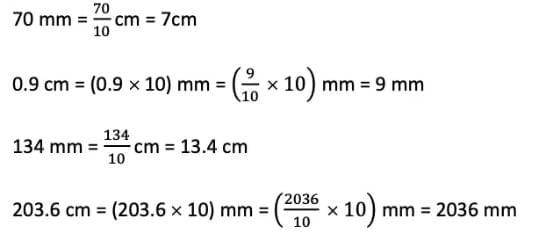

Page No. 66
Q1: Fill in the blanks below (cm ↔ m):
Ans: 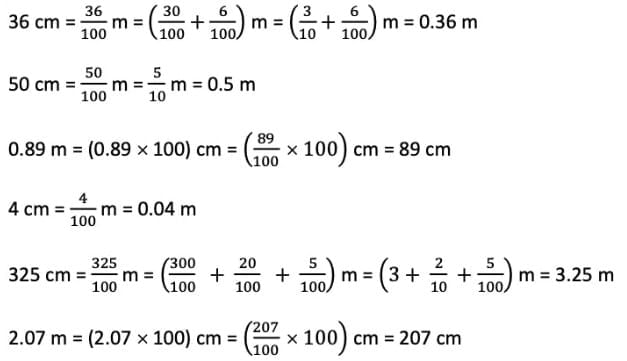

Q2: How many mm does 1 meter have?
Ans: 1 m = 100 cm = 100 × 10 mm = 1000 mm.
Q3: Can we write 1 mm = 1/1000 m?
Ans: 
Page No. 67 & 68
Q1: Fill in the blanks below (g ↔ kg)
Ans: 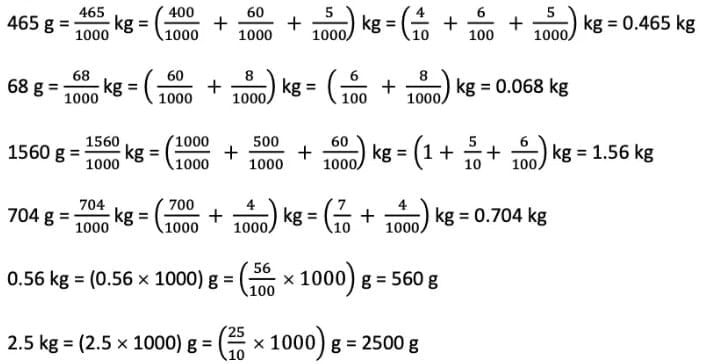

Page No. 69
Q1: Fill in the blanks below (rupee ↔ paise)
Ans: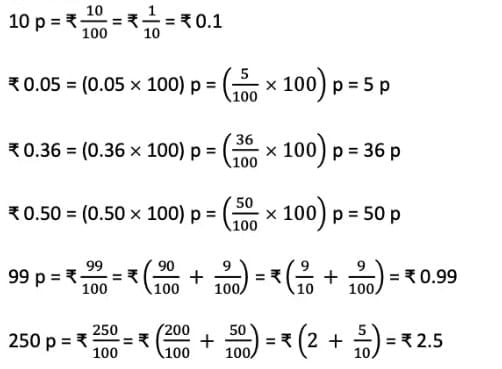

Page No. 70 & 71
Q1: Name all the divisions between 1 and 1.1 on the number line. Ans: The divisions between 1 and 1.1 are: 1.01, 1.02, 1.03, 1.04, 1.05, 1.06, 1.07, 1.08 and 1.09.
Ans: The divisions between 1 and 1.1 are: 1.01, 1.02, 1.03, 1.04, 1.05, 1.06, 1.07, 1.08 and 1.09.
Q2: Identify and write the decimal numbers against the letters. Ans: A = 5.09
Ans: A = 5.09
B = 5.13
C = 5.20
D = 5.31
Q3: Sonu says that 0.2 can also be written as 0.20, 0.200; Zara thinks that putting zeros on the right side may alter the value of the decimal number. What do you think?
Ans: Sonu is correct. 0.2 = 0.20 = 0.200, as trailing zeros after the decimal point do not change the value (they represent 0 hundredths, 0 thousandths, etc.). Zara is incorrect.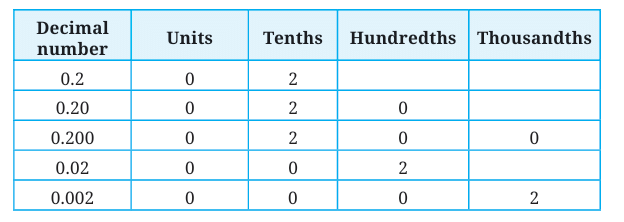
We can see that 0.2, 0.20, and 0.200 are all equal as they represent the same quantity, i.e., 2 tenths. But 0.2, 0.02, and 0.002 are different.
Q4: Can you tell which of these is the smallest and which is the largest?
Ans: From the table above: 0.002 < 0.02 < 0.2 = 0.20 = 0.200
Smallest = 0.002
Largest = 0.2
Q5: Which of these are the same: 4.5, 4.05, 0.405, 4.050, 4.50, 4.005, 04.50?
Ans: 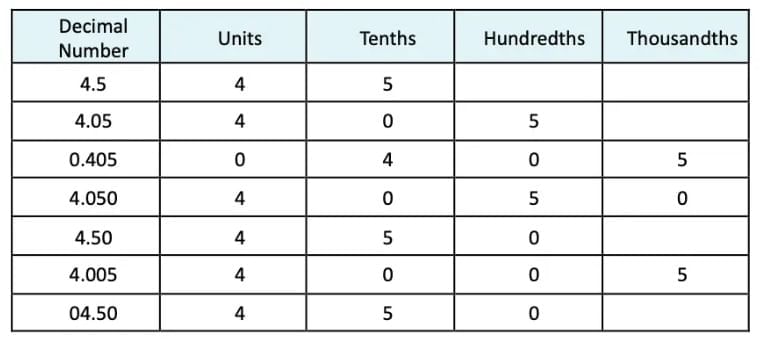
4.5, 4.50, and 04.50 are equal as they represent the same quantity, i.e., four ones and five tenths.
Similarly, 4.05 and 4.050 are equal as they represent the same quantity, i.e., four ones and five hundredths.
But, 0.405 and 4.005 are different as they do not represent the same quantity.
Observe the number lines in Figure (a) below. At each level, a particular segment of the number line is magnified to locate the number 4.185.
Q6: Identify the decimal number in the last number line in Figure (b) denoted by ‘?’.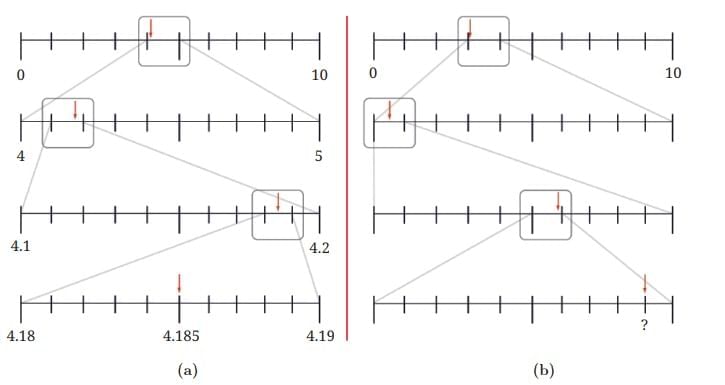 Ans:
Ans: 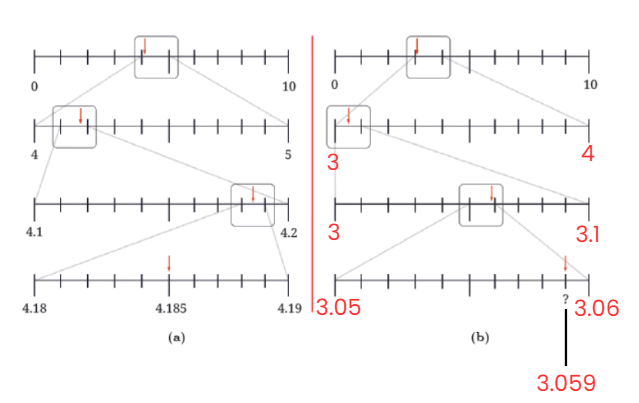 Q7: Make such number lines for the decimal numbers:
Q7: Make such number lines for the decimal numbers:
(a) 9.876
(b) 0.407.
Ans: (a) 9.876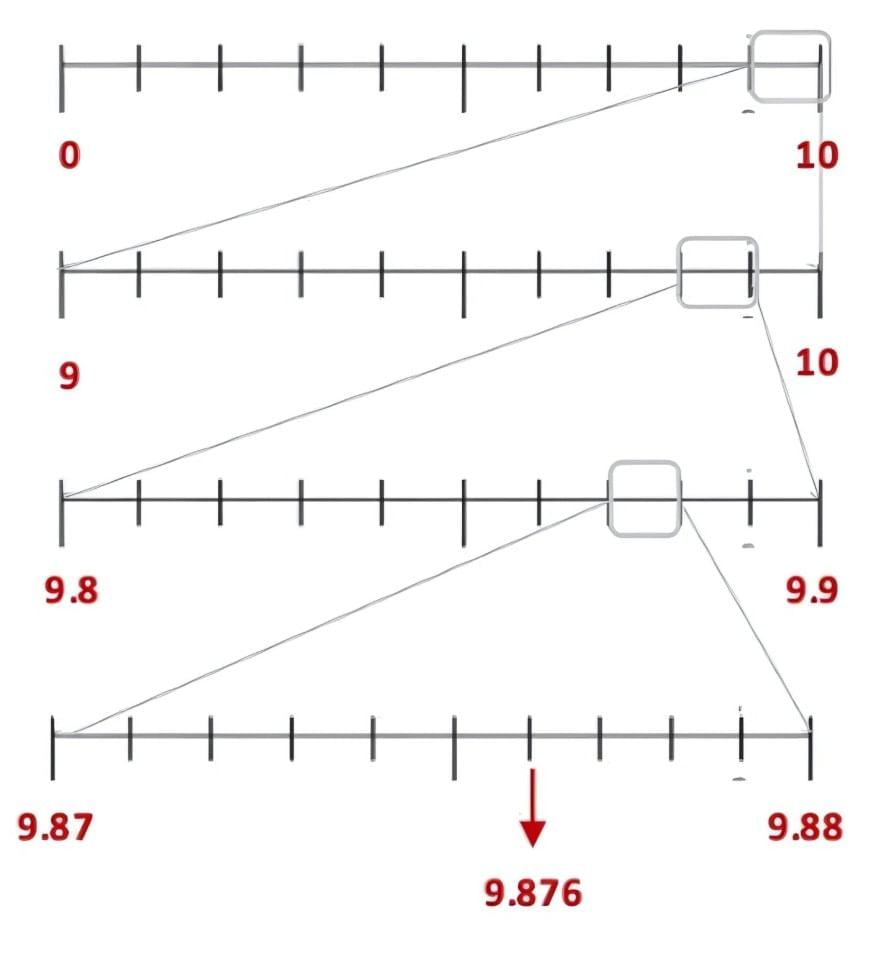
(b) 0.407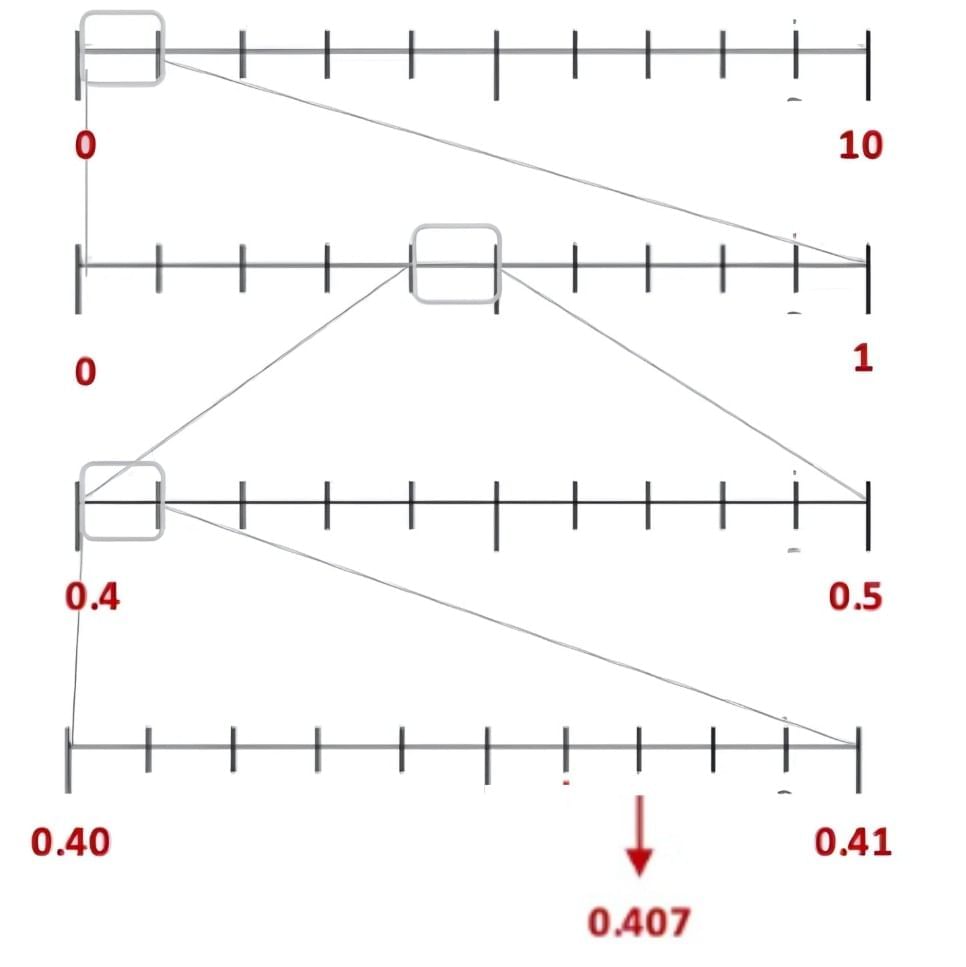
Q8: In the number line shown below, what decimal numbers do the boxes labelled 'a', 'b', and 'c' denote?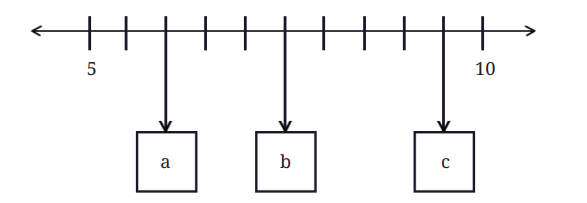
Ans: We are given that the number line from 5 to 10 is divided into 10 equal parts.
So, each small division  .
.
Therefore,
a = 5 + (2 × 0.5) = 5 + 1 = 6
b = 5 + (5 × 0.5) = 5 + 2.5 = 7.5
c = 5 + (9 × 0.5) = 5 + 4.5 = 9.5
Page No. 72
Q1: Using similar reasoning find out the decimal numbers in the boxes below.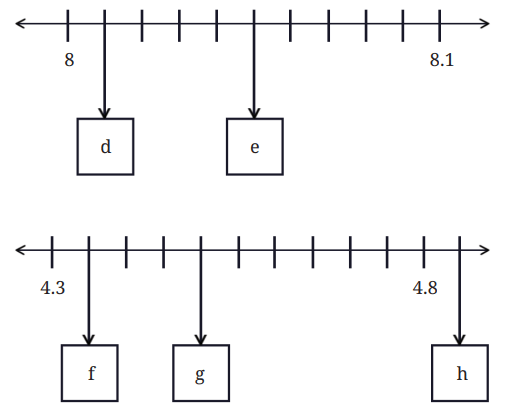
Ans: 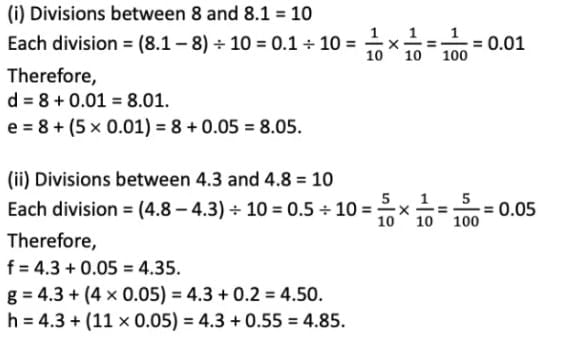
Q2: Which is larger: 6.456 or 6.465?
Ans: To answer this, we can use the number line to locate both decimal numbers and which is larger.
This can also be done by comparing the corresponding digits at each place value, as we do with whole numbers. This comparison is visualised step by step below.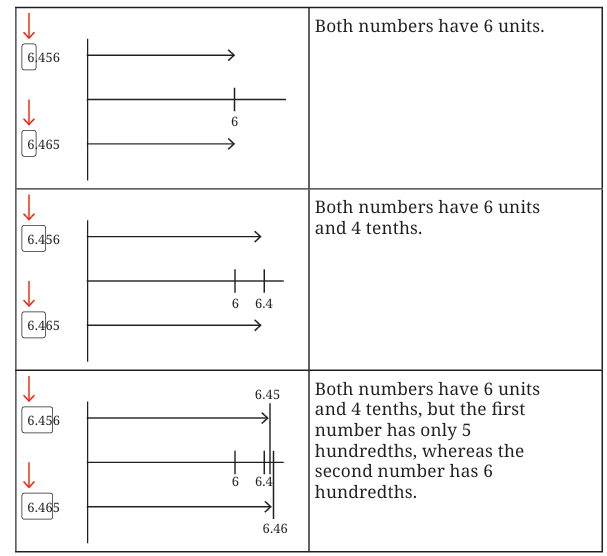
Page No. 73
Q1: Why can we stop comparing at this point? Can we be sure that whatever digits are there after this will not affect our conclusion?
Ans: We stop comparing as soon as we find different digits because each digit’s place value matters.
In 6.465 and 6.456, both numbers are equal up to the tenths and hundredths place.
In the thousandths place, 6.465 has 5, and 6.456 has 6.
So, we compare 5 and 6.
Since 5 < 6, we know that 6.456 < 6.465.
Even if there are more digits after the thousandths place, they cannot change the fact that 465 thousandths is more than 456 thousandths.
Q2: Which decimal number is greater?
(a) 1.23 or 1.32
(b) 3.81 or 13.800
(c) 1.009 or 1.090
Ans: (a) Using the decimal place value chart, we find that:
Both numbers have 1 unit, but the first number has 2 tenths, whereas the second number has 3 tenths.
Therefore, 1.23 < 1.32.
(b) Using the decimal place value chart, we find that:
 Here, the first number has 3 units, whereas the second number has 1 ten and 3 units.
Here, the first number has 3 units, whereas the second number has 1 ten and 3 units.
Therefore, 3.81 < 13.800.
(c) Using the decimal place value chart, we find that: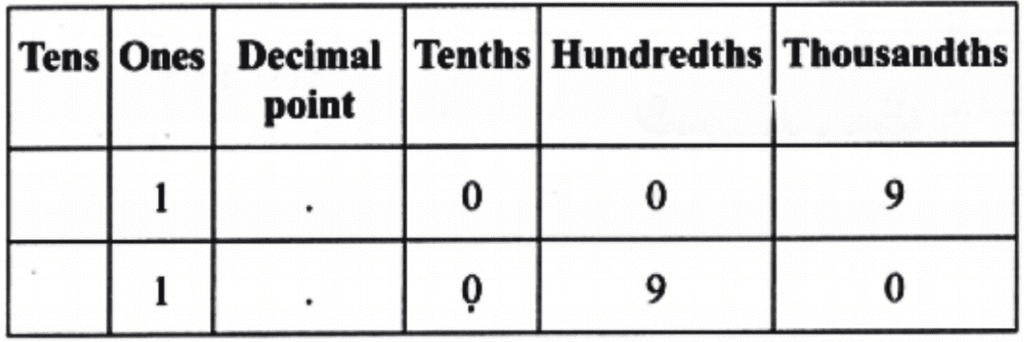 Both numbers have 1 unit and 0 tenths, but the first number has 0 hundredths, whereas the second number has 9 hundredths.
Both numbers have 1 unit and 0 tenths, but the first number has 0 hundredths, whereas the second number has 9 hundredths.
Therefore, 1.009 < 1.090.
Consider the decimal numbers 0.9, 1.1, 1.01, and 1.11. Identify the decimal number that is closest to 1.
Let us compare the decimal numbers. Arranging these in ascending order, we get 0.9 < 1 < 1.01 < 1.1 < 1.11. Among the neighbours of 1, 1.01 is 1/100 away from 1 whereas 0.9 is 10/100 away from 1. Therefore, 1.01 is closest to 1.
Q3: Which of the above is closest to 1.09?
Ans: Arranging all numbers in ascending order:
0.9 < 1.01 < 1.09 < 1.1 < 1.11
Here, neighbours of 1.09 are 1.01 and 1.1.
1.1 (or 1.10) is away from 1.09
1.01 is away from 1.09
Therefore, 1.1 is closest to 1.09.
Q4: Which among these is closest to 4: 3.56, 3.65, 3.099?
Ans: Arranging the decimal numbers in ascending order, we have 3.099 < 3.56 < 3.65 < 4
3.65 is closest to 4 among the given decimal numbers.
Q5: Which among these is closest to 1: 0.8, 0.69, 1.08?
Ans: Arranging all numbers in ascending order:
0.69 < 0.8 < 1.08
Now, compare the distance of each number from 1:
1 - 0.69 = 0.31
1 - 0.8 = 0.2
1.08 - 1 = 0.08
Among these, 1.08 has the smallest distance from 1.
Therefore, 1.08 is closest to 1.
Q6: In each case below use the digits 4, 1, 8, 2, and 5 exactly once and try to make a decimal number as close as possible to 25.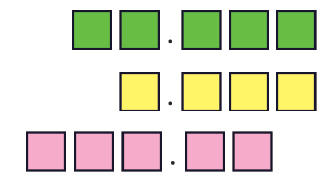 Ans: We can make a decimal number closest to 25 using the digits 4, 1, 8, 2, and 5 with the given conditions as follows:
Ans: We can make a decimal number closest to 25 using the digits 4, 1, 8, 2, and 5 with the given conditions as follows: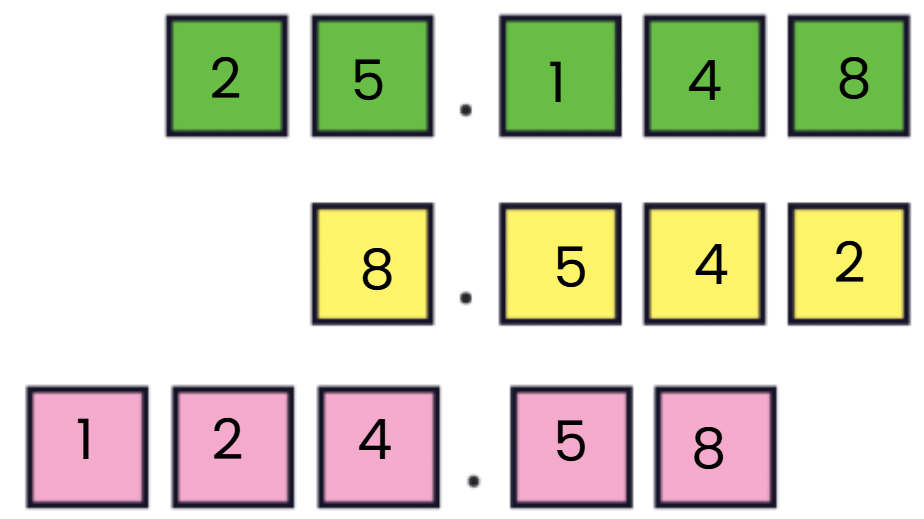
Page No. 75
Q1: Write the detailed place value computation for 84.691 − 77.345, and its compact form.
Ans: We can find the difference of 84.691 – 77.345 as follows: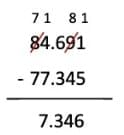
Figure it Out
Q1: Find the sums:
(a) 5.3 + 2.6
(b) 18 + 8.8
(c) 2.15 + 5.26
(d) 9.01 + 9.10
(e) 29.19 + 9.91
(f ) 0.934 + 0.6
(g) 0.75 + 0.03
(h) 6.236 + 0.487
Ans: 
Q2: Find the differences:
(a) 5.6 – 2.3
(b) 18 – 8.8
(c) 10.4 – 4.5
(d) 17 – 16.198
(e) 17 – 0.05
(f) 34.505 – 18.1
(g) 9.9 – 9.09
(h) 6.236 – 0.487
Ans: 
Decimal Sequences
Observe this sequence of decimal numbers and identify the change after each term.
4.4, 4.8. 5.2, 5.6, 6.0, …
We can see that 0.4 is being added to a term to get the next term.
Continue this sequence and write the next 3 terms.
Ans:
4.4, 4.8. 5.2, 5.6, 6.0, 6.4, 6.8, 7.2
Page No. 76
Q1: Similarly, identify the change and write the next 3 terms for each sequence given below. Try to do this computation mentally.
(a) 4.4, 4.45, 4.5, …
(b) 25.75, 26.25, 26.75, …
(c) 10.56, 10.67, 10.78, …
(d) 13.5, 16, 18.5, …
(e) 8.5, 9.4, 10.3, …
(f) 5, 4.95, 4.90, …
(g) 12.45, 11.95, 11.45, …
(h) 36.5, 33, 29.5, …
Ans: (a) 4.4, 4.45, 4.5, ...
Each term increases by 0.05
Next after 4.5:
Next:
Next:
∴ Next 3 terms are 4.55, 4.6, 4.65
(b) 25.75, 26.25, 26.75, ...
Each term increases by 0.5
Next after 26.75:
Next:
Next:
∴ Next 3 terms are 27.25, 27.75, 28.25
(c) 10.56, 10.67, 10.78, ...
Each term increases by 0.11
Next after 10.78:
Next:
Next:
∴ Next 3 terms are 10.89, 11.00, 11.11
(d) 13.5, 16, 18.5, ...
Each term increases by 2.5
Next after 18.5:
Next:
Next:
∴ Next 3 terms are 21.0, 23.5, 26.0
(e) 8.5, 9.4, 10.3, ...
Each term increases by 0.9
Next after 10.3:
Next:
Next:
∴ Next 3 terms are 11.2, 12.1, 13.0
(f) 5, 4.95, 4.90, ...
Each term decreases by 0.05
Next after 4.90:
Next: 4.85−0.05=4.80
Next: 4.80−0.05=4.75
∴ Next 3 terms are 4.85, 4.80, 4.75
(g) 12.45, 11.95, 11.45, ...
Each term decreases by 0.5
Next after 11.45:
Next:
Next:
∴ Next 3 terms are 10.95, 10.45, 9.95
(h) 36.5, 33, 29.5, ...
Each term decreases by 3.5
Next after 29.5:
Next:
Next:
∴ Next 3 terms are
Q2: Make your own sequences and challenge your classmates to extend the pattern.
Ans: Do it Yourself!
Estimating Sums and Differences
Sonu has observed sums and differences of decimal numbers and says, “If we add two decimal numbers, then the sum will always be greater than the sum of their whole number parts. Also, the sum will always be less than 2 more than the sum of their whole number parts.” Let us use an example to understand what his claim means:
If the two numbers to be added are 25.936 and 8.202, the claim is that their sum will be greater than 25 + 8 (whole number parts) and will be less than 25 + 1 + 8 + 1.
Q3: What do you think about this claim? Verify if this is true for these numbers. Will it work for any 2 decimal numbers?
Ans: Both the claims hold true
Verifying for 25.936 and 8.202
Verifying with other numbers

Q4: What about for the sum of 25.93603259 and 8.202?
Ans: The given numbers are 25.93603259 and 8.202.
Sum of whole number parts = 25 + 8 = 33
Sum of given decimal numbers = 25.93603259 + 8.202 = 34.13803259
Clearly, 33 < 34.13803259 < (33 + 2)

Q5: Similarly, come up with a way to narrow down the range of whole numbers within which the difference of two decimal numbers will lie.
Ans: Numbers:
25.936 and 8.202
Step 1: Whole number parts:
25 − 8 = 17
Step 2: Full decimal subtraction:
25.936 − 8.202 = 17.734
So the difference:
- Is less than 25 − 8 + 1 = 18
- Is more than 25 − (8 + 1) = 16
So we can say:
“The difference will always lie between (Whole1 − Whole2 − 1) and (Whole1 − Whole2 + 1)”
For example:
If Whole parts are 25 and 8
→ Range of difference = Between 16 and 18
→ Actual difference = 17.734 lies in the range.
Page No. 78
Q: Where else can we see such 'non-decimals' with a decimal-like notation?
Ans: Do it Yourself!
Q1: Convert the following fractions into decimals: Ans:
Ans: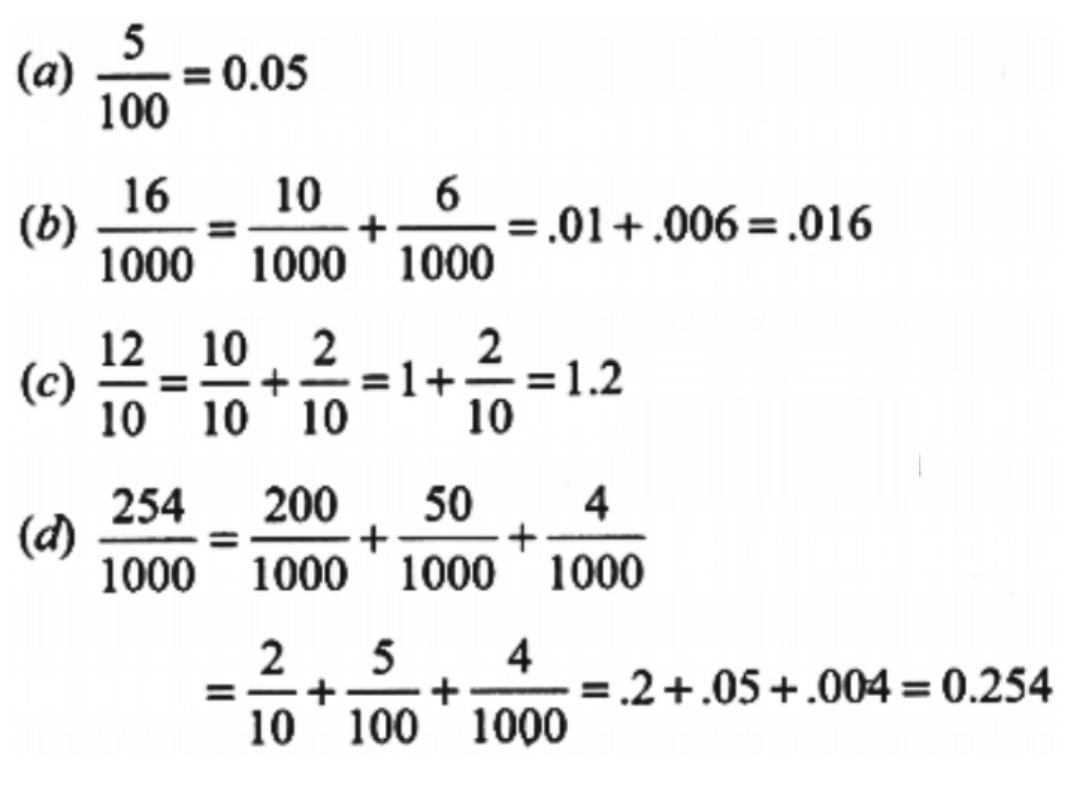
Page no. 79
Q2: Convert the following decimals into a sum of tenths, hundredths, and thousandths:
(a) 0.34
(b) 1.02
(c) 0.8
(d) 0.362
Ans: 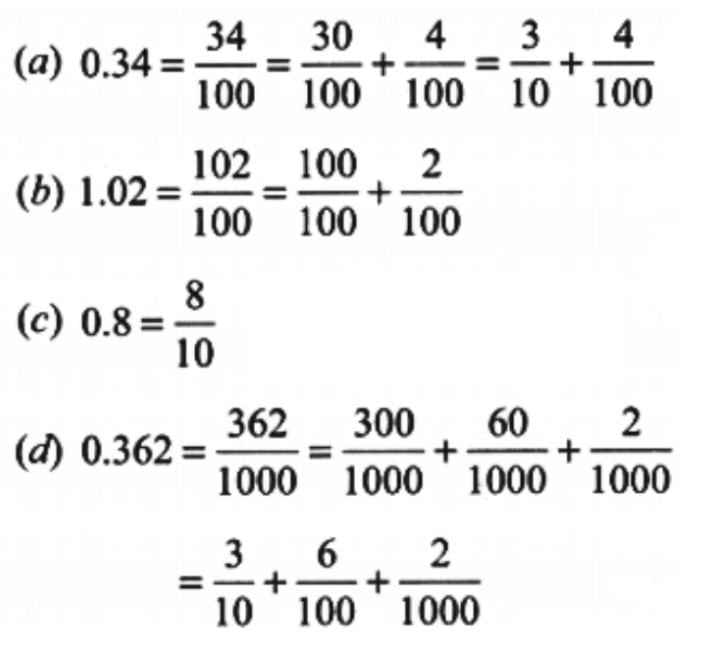
Q3: What decimal number does each letter represent in the number line below?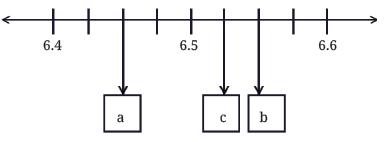 Ans: There are 4 divisions between 6.4 and 6.5, so each division is one-fourth part of 0.1 or 1/10, i.e., 1/40 = 0.025 unit. Therefore,
Ans: There are 4 divisions between 6.4 and 6.5, so each division is one-fourth part of 0.1 or 1/10, i.e., 1/40 = 0.025 unit. Therefore,
- a: 6.45
- b: 6.55
- c: 6.525
Q4: Arrange the following quantities in descending order:
(a) 11.01, 1.011, 1.101, 11.10, 1.01
Ans: (a) Using the decimal place value chart, we find that: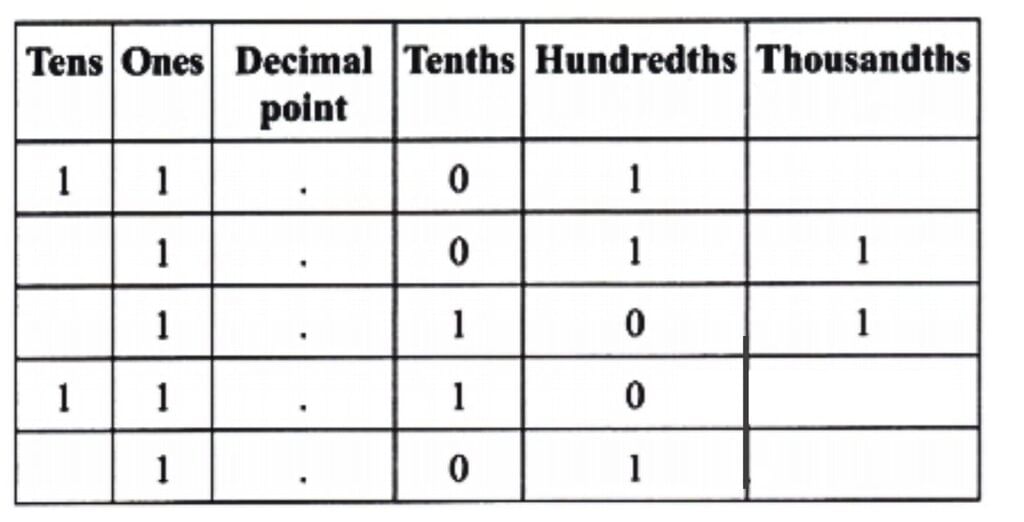
Here, the two numbers 11.01 and 11.10 have 11 whole-number parts, but the first number has 0 tenths, whereas the second number has 1 tenth. Therefore, 11.10 > 11.01. The three numbers 1.011, 1.101, and 1.01 have 1 whole number part, but the first and third numbers have 0 tenths, whereas the second number has 1 tenth. Therefore, 1.101 is the greatest among the three. Now, comparing the remaining two numbers, we get 1.011 > 1.01.
Thus, the numbers in descending order are: 11.10 > 11.01 > 1.101 > 1.011 > 1.01.
Similarly, we can arrange the other given quantities using a decimal place value chart as follows:
(b) 2.567, 2.675, 2.768, 2.499, 2.698
Ans: 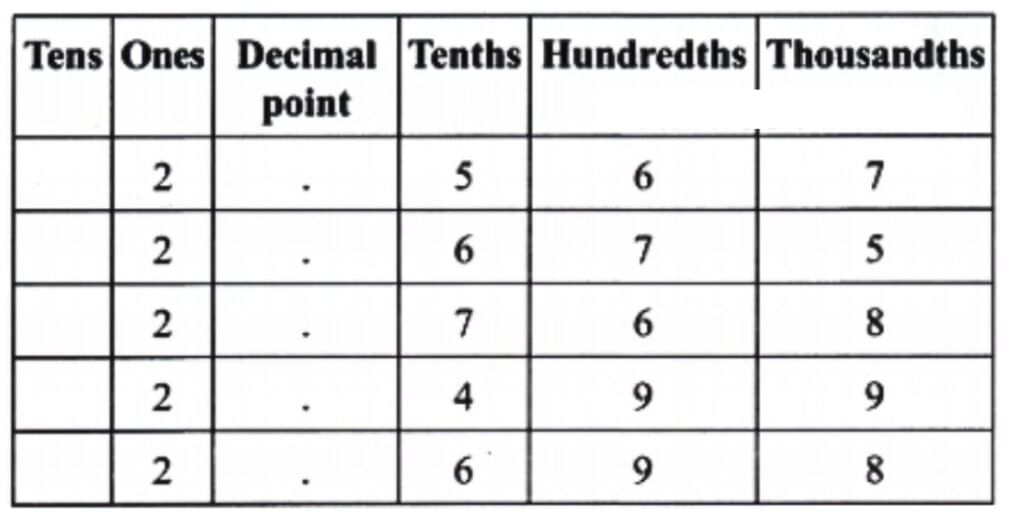 Thus, the given quantities in descending order are:
Thus, the given quantities in descending order are:
2.768 > 2.698 > 2.675 > 2.567 > 2.499
(c) 4.678 g, 4.595 g, 4.600 g, 4.656 g, 4.666 g
Ans: 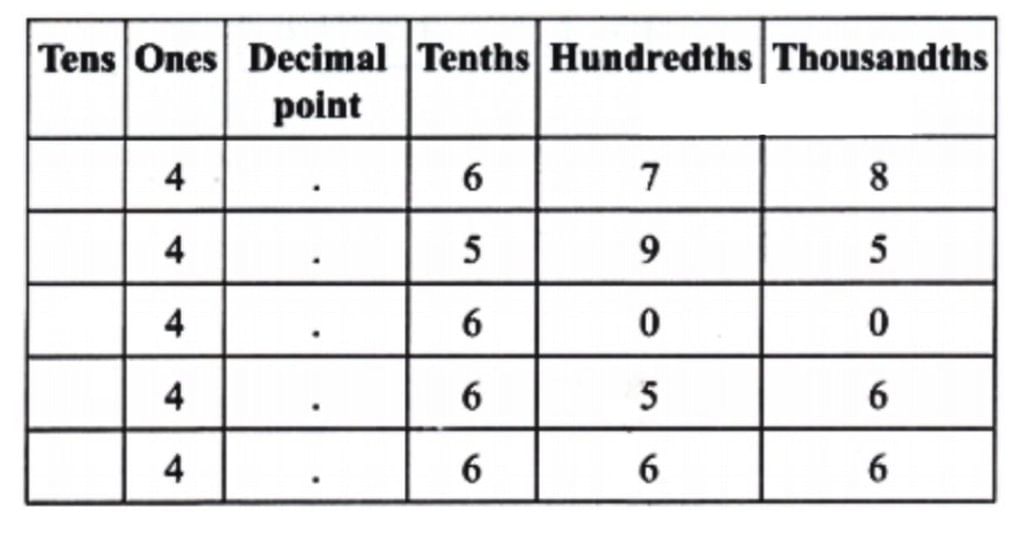 Thus, the given quantities in descending order are:
Thus, the given quantities in descending order are:
4.678 g > 4.666 g > 4.656 g > 4.600 g > 4.595 g.
(d) 33.13 m, 33.31 m, 33.133 m, 33.331 m, 33.313 m
Ans: 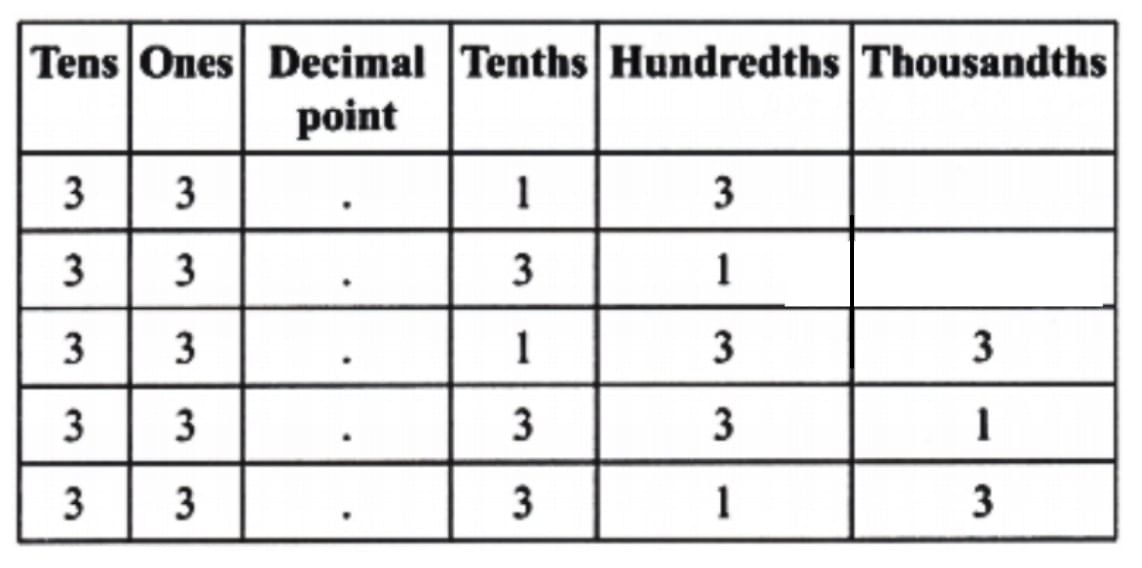 Thus, the given quantities in descending order are:
Thus, the given quantities in descending order are:
33.331 m > 33.313 m> 33.31 m > 33.133 m > 33.13 m.
Q5: Using the digits 1, 4, 0, 8, and 6 make:
(a) the decimal number closest to 30
(b) the smallest possible decimal number between 100 and 1000.
Ans: Using the digits 1, 4, 0, 8, and 6, we can make:
(a) The decimal number closest to 30 → 40.168.
(b) The smallest possible decimal number between 100 and 1000 → 104.68
Q6: Will a decimal number with more digits be greater than a decimal number with fewer digits?
Ans: No, the number of digits doesn’t determine size. Compare: 1.2 (fewer digits) > 0.9999 (more digits). Size depends on place value comparison.
Q7: Mahi purchases 0.25 kg of beans, 0.3 kg of carrots, 0.5 kg of potatoes, 0.2 kg of capsicums, and 0.05 kg of ginger. Calculate the total weight of the items she bought.
Ans: The total weight of the items Mahi bought = 0.25 kg + 0.3 kg + 0.5 kg + 0.2 kg + 0.05 kg = 1.3 kg.
Q8: Pinto supplies 3.79 L, 4.2 L, and 4.25 L of milk to a milk dairy in the first three days. In 6 days, he supplies 25 litres of milk. Find the total quantity of milk supplied to the dairy in the last three days.
Ans: The total quantity of milk supplied to the dairy in the last three days = Total milk supplied in the 6 days – Total milk supplied in the first 3 days
= 25 L – (3.79 L + 4.2 L + 4.25 L)
= 25 L – 12.24 L
= 12.76 L
Q9: Tinku weighed 35.75 kg in January and 34.50 kg in February. Has he gained or lost weight? How much is the change?
Ans: Since 35.75 kg > 34.50 kg, Tinku has lost weight.
Now, the change in the weight = 35.75 kg – 34.50 kg = 1.25 kg.
Q10: Extend the pattern: 5.5, 6.4, 6.39, 7.29, 7.28, 6.18, 6.17 _______,_______.
Ans: Let us analyse the given pattern:
5.5 (+0.9) 6.4 (-0.01) 6.39 (+0.9) 7.29 (-0.01) 7.28 (+0.9) 8.18 (-0.01) 8.17.
So, the sequence follows an increasing trend of 0.9 and then a decreasing trend of 0.01 alternatively.
Thus, the next two numbers are 9.07 and 9.06.
Q11: How many millimeters make 1 kilometer?
Ans: We know that 1 km = 1000 m and 1 m = 1000 mm
Therefore, 1 km = 1000 × 1000 mm= 1000000 mm.
Q12: Indian Railways offers optional travel insurance for passengers who book e-tickets. It costs 45 paise per passenger. If 1 lakh people opt for insurance in a day, what is the total insurance fee paid?
Ans: The insurance fee paid for 1 passenger = 45 p = ₹ 0.45
So, total insurance fee paid for 1 lakh passengers = ₹ 0.45 × 100000 = ₹ 45000
Q13: Which is greater?
(a) 10/1000 or 1/10?
(b) One-hundredth or 90 thousandths?
(c) One-thousandth or 90 hundredths?
Ans: 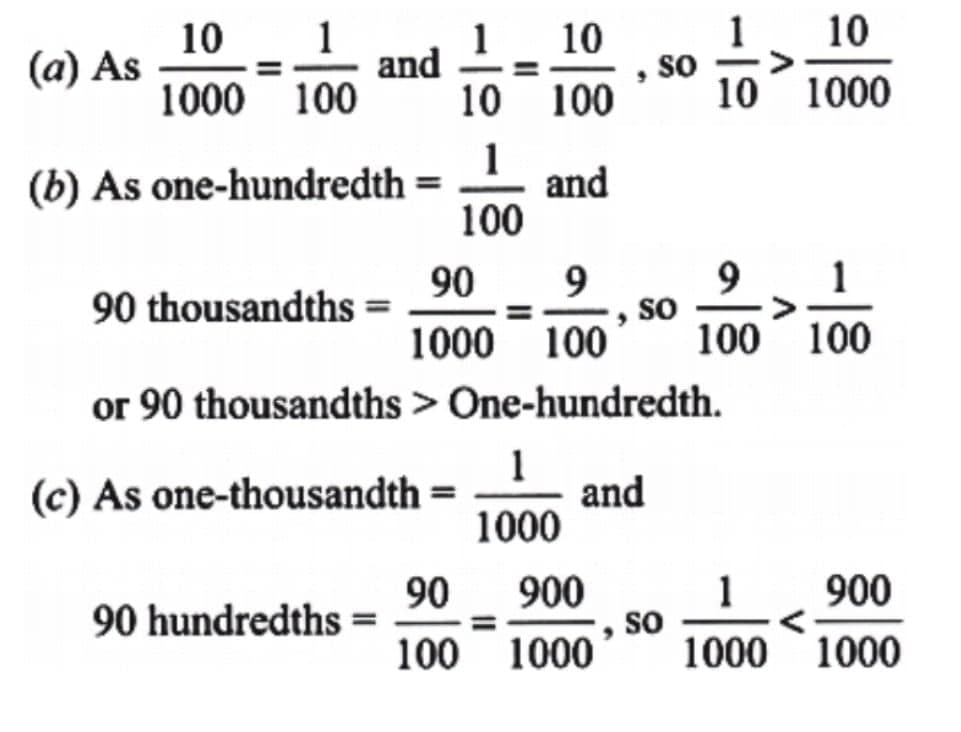
Page no. 80
Q14: Write the decimal forms of the quantities mentioned:
(a) 87 ones, 5 tenths and 60 hundredths = 88.10
(b) 12 tens and 12 tenths
(c) 10 tens, 10 ones, 10 tenths, and 10 hundredths
(d) 25 tens, 25 ones, 25 tenths, and 25 hundredths
Ans:
(a) 87 ones, 5 tenths, 60 hundredths = 87 + 0.5 + 0.60 = 88.10.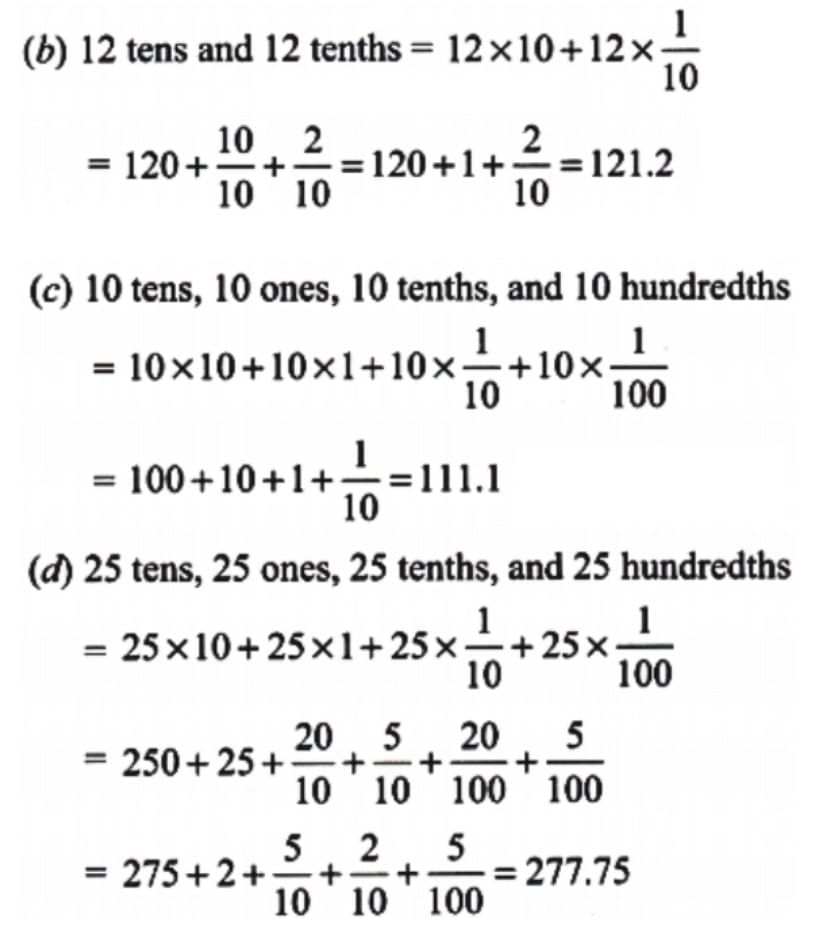
Q15: Using each digit 0 – 9 not more than once, fill the boxes below so that the sum is closest to 10.5: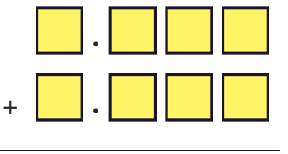 Ans:
Ans: 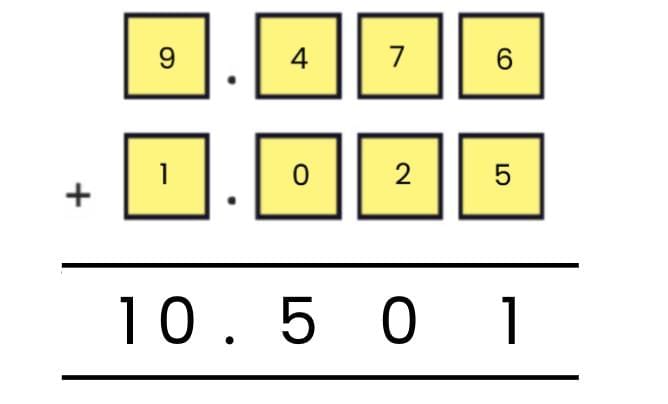 Q16: Write the following fractions in decimal form:
Q16: Write the following fractions in decimal form:
(a) 1/2
(b) 3/2
(c) 1/4
(d) 3/4
(e) 1/5
(f) 4/5
Ans: 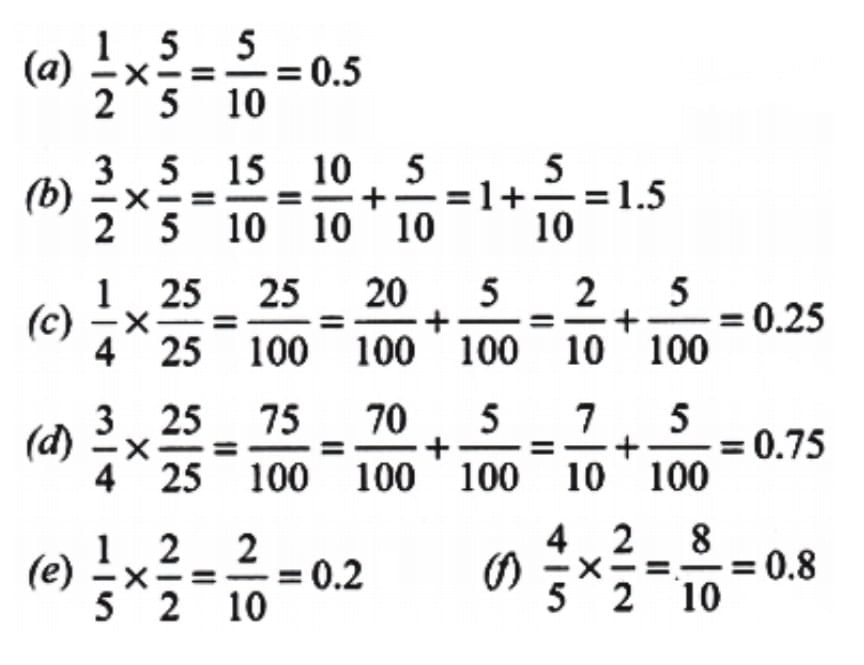
|
41 videos|316 docs|8 tests
|
FAQs on NCERT Solutions for Class 7 Maths Chapter 3 A Peek Beyond the Point
| 1. What are the main topics covered in the NCERT Class 7 curriculum? |  |
| 2. How can NCERT Solutions help students in their studies? |  |
| 3. Are NCERT Solutions useful for competitive exams? |  |
| 4. Where can I find NCERT Solutions for Class 7? |  |
| 5. How should students effectively use NCERT Solutions for revision? |  |






















